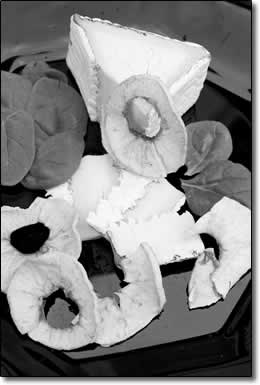
Spring cheese incident
by Chef Boy Ari

I'm fascinated by cheese. How can the secretions of bovine and ungulate mammary glands transform into so many textures, flavors and colors? Standing in the cheese section of the grocery store can be an overwhelming experience, and I wonder helplessly where to begin.
Last week, the store's cheese purchaser had the answer. "Now is the best time of the year for fresh goat cheese," he said, "because spring goat milk has the highest content of butterfat, protein and sugar."
He referred me (and my barrage of questions) to the Idaho cheese maker who gave him this information: Chuck Evans, of Rollingstone Ch`E8vre, of Parma, Idaho. Rollingstone cheeses, made from the milk of their herd of purebred Saanen goats, has won top honors at many cheese competitions. In addition to the usual goat cheeses like ch`E8vre and fromage blanc, Rollingstone also produces an aged grating cheese called Idaho Goatster and a surface-ripened aged ch`E8vre called Bleu Agé.
The word ch`E8vre used to mean "she goat" in Old French. If you can speak French, says Evans, then you roll the "r." Otherwise, forget about it and just say "Chev." Today, ch`E8vre is sometimes used as a generic word for goat cheese, but it usually refers to a specific type of fresh goat cheese that is soft, creamy, tangy, bright white and sometimes spiced. Ch`E8vre - and goat cheese in general - has shot up in national popularity in recent decades.
Long popular in Europe, legend has it that the American goat cheese revolution started in northern California during the late 1970s, growing out of the partnership between Chef Alice Waters, of Berkley's Chez Panisse Café, and Sonoma cheese maker Laura Chenel. Waters put ch`E8vre on the map with a salad that includes half-inch rounds of cheese marinated up to a week in olive oil, rosemary and thyme. The cheese is then dusted with bread crumbs, warmed in the oven, and served atop a bed of baby greens with a vinaigrette of wine and sherry and whisked-in olive oil, salt and black pepper.
Many people associate goats with small, cute farms run by small, cute milkmaids. There is some truth to this. But like many small things spoiled by popularity, many goat dairy operators have now become impersonal and industrialized, much like the cow dairy industry. This has created a need for the category of "farmstead cheese," which means that the goats were raised at the same place and by the same people who make the cheese. This lets consumers know that they are buying from a small-ish outfit, where quality control can presumably be assured from start to finish.
Interestingly, within the farmstead scene, you do see a surprising proportion of female operators. Perhaps this is because goats are smaller and easier to manage than cows. You can also form personal relationships with goats; women dig that. Unfortunately, the marketing advantages of labeling cheese "farmstead" have tempted some cheese makers, male and female, to use the label even if they buy some or all of their milk. Rumors and accusations fly in the goat cheese world over who is truly farmstead, and who is a closet fluid-milk buyer.
The cheese purchaser has no doubt that Rollingstone is a true farmstead cheese. "They are one of our two suppliers who stop sending fresh cheese in the winter," he says.
"If you want to purchase fluid milk you can make cheese all year long," explains Evans. Big milk producers use hormones and play with light conditions to get goats to lactate through the winter. "It's barely fit to drink, but you can buy it."
Milk production naturally drops in fall as the ch`E8vres prepare to make next year's kids. As volume decreases, the proportion of total solids rises, resulting in milk that's high in fat and protein. But unlike the sweet and supple spring cheese made from milk designed to nourish young kids, fall cheese is aged and savory, with a summer's worth of meals and mishaps built into the flavor.
"Fall cheese is earthy," says Evans, "so I serve it with earthy things, like borscht."
Whatever you do, you should let it warm at least to room temperature before serving, to maximize the flavor.
Playing with the possibilities of springtime, I mashed ch`E8vre with chopped dates and made little balls that I wrapped in bacon (held together with toothpicks), and broiled at 350 until golden brown. These morsels were a bit fatty for some tasters, but perfect for others. All tasters were deeply impressed with the warm combination of date and ch`E8vre. Scrambled eggs with ch`E8vre, minced garlic and chopped fresh basil made for a superb breakfast. But if you like your eggs well cooked, beware. The cheese imparts an undercooked appearance long after the eggs are done.
In the end, my favorite presentation was simply room-temperature ch`E8vre and dried apples. Chewing them together, the flavors devoured each other as they devoured my mouth, the wild tang of apples and the tart cream of the mammary gland. Simple, serious, pleasure.
|